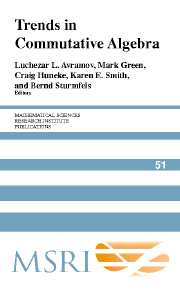Book contents
- Frontmatter
- Contents
- Preface
- Commutative Algebra in the Cohomology of Groups
- Modules and Cohomology over Group Algebras
- An Informal Introduction to Multiplier Ideals
- Lectures on the Geometry of Syzygies
- Commutative Algebra of n Points in the Plane
- Tight Closure Theory and Characteristic p Methods
- Monomial Ideals, Binomial Ideals, Polynomial Ideals
- Some Facts About Canonical Subalgebra Bases
Commutative Algebra of n Points in the Plane
Published online by Cambridge University Press: 06 July 2010
- Frontmatter
- Contents
- Preface
- Commutative Algebra in the Cohomology of Groups
- Modules and Cohomology over Group Algebras
- An Informal Introduction to Multiplier Ideals
- Lectures on the Geometry of Syzygies
- Commutative Algebra of n Points in the Plane
- Tight Closure Theory and Characteristic p Methods
- Monomial Ideals, Binomial Ideals, Polynomial Ideals
- Some Facts About Canonical Subalgebra Bases
Summary
Abstract. We study questions arising from the geometry of configurations of n points in the affine plane ℂ2. We first examine the ideal of the locus where some two of the points coincide, and then study the rings of invariants and coinvariants for the action of the symmetric group Sn permuting the points among themselves. We also discuss the ideal of relations among the slopes of the lines that connect the n points pairwise, which is the subject of beautiful and surprising results by Jeremy Martin.
Introduction
These lectures address commutative algebra questions arising from the geometry of configurations of n points in the affine plane ℂ2. In the first lecture, we study the ideal of the locus where some two of the points coincide. We are led naturally to consider the action of the symmetric group Sn permuting the points among themselves. This provides the topic for the second lecture, in which we study the rings of invariants and coinvariants for this action. As you can see, we have chosen to study questions that involve rather simple and naive geometric considerations. For those who have not encountered this subject before, it may come as a surprise that the theorems which give the answers are quite remarkable, and seem to be hard.
One reason for the subtlety of the theorems is that lurking in the background is the more subtle geometry of the Hilbert scheme of points in the plane.
- Type
- Chapter
- Information
- Trends in Commutative Algebra , pp. 153 - 180Publisher: Cambridge University PressPrint publication year: 2004
- 3
- Cited by

